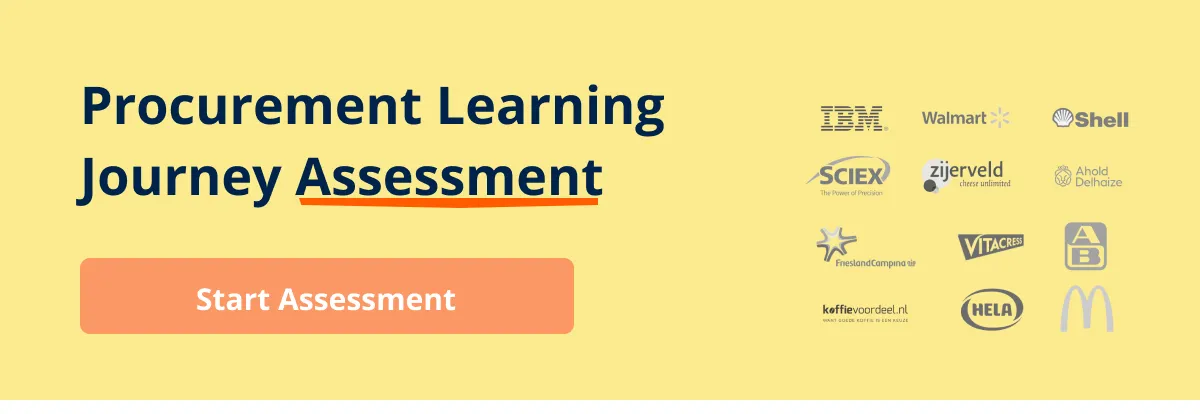Written by Marijn Overvest | Reviewed by Sjoerd Goedhart | Fact Checked by Ruud Emonds | Our editorial policy
Procurement KPIs — The Ultimate Guide
Key takeaways
- Procurement KPIs) are tools to measure how effective the company is at achieving its objectives and goals.
- They help businesses stay competitive by optimizing spending, quality, costs, and timelines.
- Procurement KPIs promote long-term growth by facilitating efficiency, informed decision-making, and strategic alignment.
Procurement Key Performance Indicators (KPIs) are crucial to a company. It is what companies use to assess if their performance is good enough to compete with other companies in the market. But first, what are these indicators?
In this article, we will discuss what procurement KPIs are. We will discuss the need for procurement KPIs and the most important KPIs to track your process in procurement.
Reading this article will give you an idea of the importance of KPIs in your company. It will allow you to assess your processes and check some room for improvements to streamline your procurement.
Defining Procurement KPIs

Key performance indicators (KPIs), also called metrics, are tools to measure how effective the company is at achieving its objectives and goals. Therefore, procurement KPIs are types of measurement tools that evaluate the efficiency of the performance in procurement. Thus, it helps the company to optimize and monitor spending, quality, cost, and time.
Procurement KPIs allow project teams to monitor and share progress in a transparent and objective manner.
The purchase order cycle times are a crucial procurement KPI. Having a well-established KPIs can help companies to identify opportunities, manage supplier risks, and streamline the procurement processes.
The Need for KPIs in Procurement
The procurement process is not the simple procurement that people are used to before. It has grown into a business function that plays a crucial part in the growth of the business. Thus, the need for procurement KPIs is greater than ever.
It is also obvious that you cannot improve something if you cannot measure it. By using KPIs, you can measure the efficiency of the procurement process which plays a critical role in the supply chain when an emergency or economic downturn arises.
Without the KPIs in procurement, the company may not be able to see opportunities to improve its procurement and supply chain. Additionally, the company may not be able to see the problems which may turn into problems in the long run that will harm its growth.
Procurement KPIs also help procurement managers create data-driven process improvement decisions that will help the company enhance its process and its employees.
These are also some of the reasons why KPIs are needed in procurement:
- Assesses the efficiency of the procurement management of a company
- Streamlines the spending, time, quantity, and acquisition of goods and services of the company
- Allows procurement managers to make informed decisions through the data
- Aligns the procurement process with the objectives and goals of the company
- Empowers the company to decide on what to improve with their process and competitive strategy.
KPIsto Implement to Assess your Process

1. Cost reductions
Many companies are looking for ways to minimize their cost by negotiating better prices on products and materials that they need. However, some do not recognize that efficiency improvements are what they need to assess to reduce the cost of labor.
Streamlining and automating your procurement processes can reduce your labor costs. Through automation, you can lessen the need for you to hire additional staff when your demand rises.
2. Savings
Cost savings make the top management happy with your procurement strategy and this can happen by using KPI to put hard evidence of the cost savings that you are generating in front of the top management.
You can do this by keeping track of whether you will be able to get better prices when you switch to other suppliers. Additionally, to know your true savings figure, you should remember to assess and calculate unavoidable costs through KPIs.
3. Cost avoidance
Cost avoidance avoids potential extra costs that the company may incur in the future. This can be done by replacing the defective parts before they fail and damage the other parts. This is sometimes called soft savings.
Through KPIs, you can develop a strategy to map your cost avoidance and combine it with the cost reduction for you to avoid future extra costs.
4. Total spending by suppliers
By using KPIs in this process, the company can find out how many suppliers it has. Through this, you will also know if you are getting the best deal out of all your suppliers.
By consolidating the numbers of your suppliers, you can lower the costs by acquiring materials or services more affordably.
5. Procurement ROI
For many procurement professionals, procurement ROI is the most important KPI. However, it should be analyzed with the other metrics to see the bigger picture.
In calculating the procurement ROI, you will need to divide the annual cost savings by the annual internal cost and express it as a ratio. If the procurement investments are low, it is more applicable to measure hard cost savings mainly without the avoidance and other value chain improvements.
Additionally, setting it higher than the internal investment for the procurement department is a good target for your company.
6. Purchase order cycle times
You may ask yourself, how quickly does your company place a purchase order? The purchase order cycle times are a crucial procurement KPI. It demonstrates the efficiency of the operation and procurement efforts of the company against other companies.
By having a purchase order cycle times KPI, you can reduce the overall cost and productivity of the procurement functions. Additionally, the productivity of your staff can be further enhanced by reducing the cycle time of your purchase orders.
7. Contract compliance
To know if you are getting the best deal from the contract you have signed with your supplier, you must check if they are following all the terms of the contract.
You must create a contract compliance KPI in ensuring that you can make your suppliers accountable for what they have promised in the contract. If they comply with all the requirements, the company will see more opportunities for collaboration and growth.
Conclusion
The adoption of procurement KPIs is imperative for companies aiming to thrive in a competitive market. These metrics provide a comprehensive understanding of procurement efficiency, allowing for informed decision-making, cost reduction, and strategic alignment with organizational goals. Through KPI implementation, companies can proactively address challenges, seize opportunities, and optimize their procurement processes for sustained growth.
Frequentlyasked questions
What are the KPIs in procurement?
KPIs are tools to measure how effectively the company is achieving its objectives and goals.
Why are KPIs important?
Through KPIs, you can measure what improvements you can do to your procurement processes.
What are KPI tools?
KPI tools are reporting solutions used by companies to monitor, assess, and generate actionable insights from the key performance indicators of a company.
About the author
My name is Marijn Overvest, I’m the founder of Procurement Tactics. I have a deep passion for procurement, and I’ve upskilled over 200 procurement teams from all over the world. When I’m not working, I love running and cycling.


